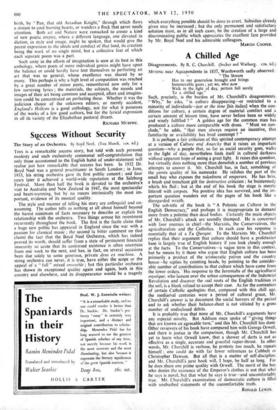The Pastoral Dream
England's Helicon. Edited by Hugh Macdonald. The Muses Library. (Routledge & Kegan Paul. 8s. 6d.) THIS Elizabethan anthology of pastoral lyrics was collected in 1600 from the works of some forty authors, among them Marlowe and Shakespeare, Spenser and Sir Philip Sidney. The best are simple, delicate poems of fancy, steeped in the manner and style of Arcadian love. Though selections from Bartholomew Yong's Diana pre- dominate in number, the spirit of the book is that of Sidney and Lodge and Shepherd Tonie, pastoral, courtly, clear and musical, luminous and fresh. " They were old-fashioned poetry," wrote Walton in The Compleat Angler," but choicely good ; I think much better than the strong lines that are now in fashion in this critical age "—a verdict more favourable than Milton's, which was " vain and amatorious."
Among these smooth songs there is nothing harsh or inhar- monious, no fracturing of the metre, little complexity in the thought ; but, instead, a perfection of clear language and homogeneous imagery, of " pretty " and not violent " conceits." As Coleridge said, these poets " placed the essence of poetry in the art." They perfected lyrical fowls. They used rhyme and numbers, assonance and alliteration, with the skill of trained musicians of words. Though sometimes their meaning may be shallow or repetitive (Bartholomew Yong wrote many tedious verses), for the better part there is some trick of sound, some artifice of style, or a new corn- binafion of the same images, or a splendid vitality, that gives life to the conventional theme of shepherd's love for shepherdess.
Though this illusory theme, this manner of making the lives of shepherds seem ideal, the revival of Arcadia in the court of Elizabeth, freshened with English landscape, may be called a convention, yet it was also for a time the natural mode, one of the spontaneous influences of love. This was a subject rich enough in itself to occupy every poet of the time. It produced at its most conventional\ The Shepherd's Calendar and the Arcadia ; at its greatest As You Like It and The Winter's'Tale. And here are all the variations of lyrical forms—Love in my bosom like a Bee, Come live with me and be my love (in no less than three versions), Beauty sat bathing by a Spring (by the admirable Shepherd Tonie)—and many more, amorous, clear and witty, strewed with roses and violets, inhabited by nymphs and dryads, by shepherds and shepherdesses of noble
birth, by " Pan, that old Arcadian Knight," through which floWs a stream to cool burning hearts, or wanders a flock that never needs attention. Both art and Nature were ransacked to create a kind of new poetic empire, where a different language, one elevated in diction, in style and image, might be spoken, that would give the purest expression to the ideals and conduct of that land, its creation being the work of no single mind, but a collective feat of which each separate poem was a part.
Such unity in the efforts of imagination is seen at its best in this anthology, where poets of more individual genius might have upset the balance or could hardly have lent themselves to perfecting an art that was so general, whose excellence was shared by so many. This perhaps is why a high level of composition was reached by a great number of minor poets, remembered now only for a few surviving lyrics ; the materials, the subjects, the moods and images of their art being common and accepted, effort and imagina- tion could be concentrated on perfecting these. Whether it was the judicious choice of the unknown editors, or merely accident, England's Helicon is a good anthology, not for what it possesses of the works of a few good authors, but for the lyrical expression in all its variety of the Elizabethan pastoral dream.
RICHARD MURPHY.







































 Previous page
Previous page